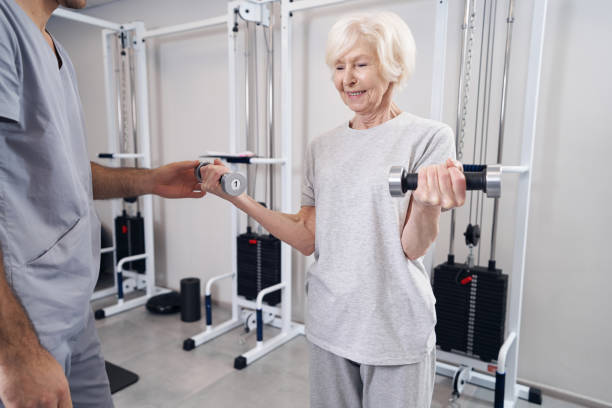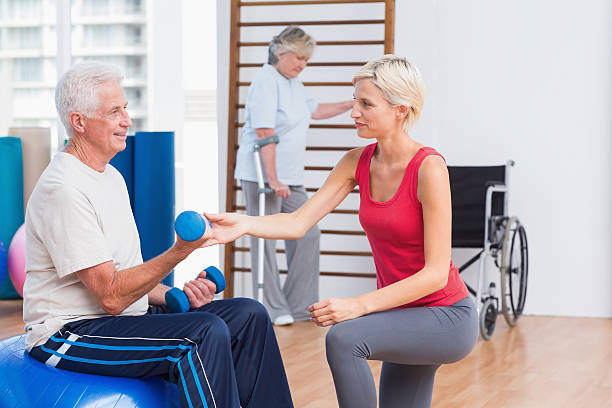Introduction

Living with Parkinson's can be a challenging experience, both for the patient and their loved ones. Discovering a workout routine that fits your unique needs and abilities can be challenging, although exercising is an effective strategy for managing symptoms, boosting mobility, and staying active.
In this blog post, we'll explore the importance of finding the right exercise program for people with Parkinson's and how it can help manage symptoms and improve their quality of life.
What is Parkinson's Disease?
The condition that is called Parkinson's disease is a disorder of the nervous system that progressively affects the way a person moves. It can cause stiff and rigid muscles, tremors, changes in speech and gait, as well as impairments in fine motor skills. In addition to the physical effects of Parkinson's, it can also cause depression and anxiety.
The Importance of Exercise for People with Parkinson's

Exercise is essential for those living with Parkinson's. Not only does exercise help to maintain muscle strength and flexibility, but it can also improve balance, decrease tremors and reduce the risk of falls. Exercise can also help manage symptoms like depression and anxiety and improve quality of life. Here are some of the benefits:
1. Improved range of motion:
Exercising regularly helps to increase the range of motion for people with Parkinson's. Range of motion is the ability of a joint or group of joints to move through a full, unrestricted arc from one extreme position to another. By performing activities that target joint flexibility and strength, such as stretching, yoga, and Pilates, people with Parkinson's can improve their range of motion, which helps to reduce stiffness and rigid muscles.
2. Increased coordination:
Exercise can also help to improve coordination and balance in people with Parkinson's. Coordinating means being able to move various parts of your body in a harmonious and synchronized manner. This includes activities such as walking, using stairs, or lifting objects. Activities that work on balance, such as Tai Chi, yoga, and Pilates, can help improve coordination and reduce the risk of falls.
3. Improved physical endurance:
Exercising regularly helps to increase physical endurance for those with Parkinson's. Physical endurance is the ability to continue performing activities without becoming weary or tired. Engaging in activities such as walking, swimming, and cycling can boost endurance levels, ultimately aiding in carrying out everyday tasks with greater ease.
4. Better posture and balance:
Exercise can also help to improve posture and balance. Posture is the alignment of your body when standing or sitting and how you move and carry yourself. The definition of balance is the capacity to keep stability while being stationary or in motion. By strengthening the muscles surrounding your spine and hips, such as by performing exercises like Pilates and yoga, people with Parkinson's can improve their posture and balance.
5. Reduced fatigue:
Exercise can also help to reduce fatigue in people with Parkinson's. Fatigue is an overwhelming feeling of tiredness and low energy. This can be caused by a variety of things, including the symptoms of Parkinson's itself. People with Parkinson's can improve their quality of life and alleviate fatigue by participating in moderate intensity exercise activities like walking or cycling.
Overall, exercise can be a valuable tool for people with Parkinson's in helping to manage symptoms and maintain physical health. It is important to find an exercise program tailored to your individual needs and abilities, as well as one that is enjoyable. With guidance from a medical professional, exercise can help improve range of motion, coordination, physical endurance, posture, balance and reduce fatigue.
6. Improved coordination and motor skills:
Exercises such as walking, running, cycling, and dancing can help to improve motor skills and coordination in people with Parkinson's. Motor skills are the ability to use your muscles to perform complex movements. This includes picking up objects, writing, or using a keyboard. Engaging in regular physical activity helps strengthen the nerves and muscles, which in turn helps improve coordination and motor skills.
7. Improved quality of life:
By engaging in regular physical activity, people with Parkinson's can improve their overall quality of life. Regular exercise helps reduce fatigue, increase energy levels, and improve range of motion, posture, and balance. It also helps to improve coordination and motor skills, which can help with activities of daily living. Exercise has also been linked with improved mood, cognitive function, sleep quality, and reduced stress and anxiety.
Finding the right exercise program is important in managing Parkinson's disease. By incorporating various activities that target range of motion, coordination, physical endurance, posture, and balance, people living with Parkinson's can improve their overall quality of life and manage symptoms effectively.
It is important to consult with a physical therapist or physician before starting any exercise program and to work closely with them throughout the process. With guidance and support, regular exercise can help people with Parkinson's improve their physical and mental health and increase their overall quality of life.
What types of exercise are best for people with Parkinson's disease?

Exercise is a critical component of managing Parkinson's disease. It can help to improve balance, coordination, flexibility, and strength.
Several types of exercise programs can benefit people with Parkinson's disease.
-
The first exercise program recommended for people with Parkinson's is aerobic or endurance exercise. Low-impact activities like walking, swimming, or cycling can improve breathing and circulation while increasing strength and mobility throughout the body.
-
Strength training is also important for people with Parkinson's. It can help increase muscle tone and slow the progression of muscle weakness and loss associated with Parkinson's. Exercises like weightlifting and resistance band training are great for increasing strength, improving range of motion, and helping to maintain balance.
-
Balance exercises are also beneficial for people with Parkinson's disease. These can help to prevent falls by improving coordination and awareness of body position in space. Choosing a combination of exercises that can challenge your balance in different ways, such as yoga or Tai Chi, is important.
-
Finally, range-of-motion exercises are essential for maintaining flexibility and mobility. These should include stretching, joint mobilization, and other activities to help increase circulation and prevent stiffness.
-
Finding the right exercise program is important for people with Parkinson's disease. Customizing your exercise routine according to your abilities and requirements is crucial. Prioritizing a consultation with your doctor or physical therapist can help determine the most suitable exercises.
-
Additionally, exercises should start slow and gradually increase in intensity as strength and mobility improve. With the right program, intense exercise can become a powerful tool for managing Parkinson's disease.
Finding the Right Program for You
Exercise is an important part of managing Parkinson's Disease, and finding the right program for you can make a big difference in your quality of life. The type of exercise program that works best for you may depend on the stage and severity of your PD symptoms.
For those with mild to moderate symptoms, low-impact exercises such as walking, bicycling, and swimming may be beneficial. However, higher-intensity activities such as running or weight training can help improve balance and mobility for those with more advanced symptoms.
No matter what type of exercise program you choose, it is important to ensure that your instructor or physical therapist understands your PD diagnosis and has experience working with people with the condition.
A qualified instructor can help you find a program tailored to your specific needs and abilities and provide guidance on proper exercise technique, safety considerations, and progress tracking. Additionally, it may be helpful to join a Parkinson's fitness community or support group to connect with others with similar experiences.
Finally, remember that exercise is only one part of managing Parkinson's Disease. It should be combined with other lifestyle changes, such as a healthy diet, stress management, and proper sleep habits, to get the most out of your treatment plan. With the right combination of exercise and lifestyle modifications, you can enjoy improved physical functioning and an enhanced quality of life.
The basic elements of exercising with Parkinson's
For individuals with PD, four main components of exercise are crucial.
-
Aerobic - For example, engaging in brisk walking or stationary cycling increases your heart rate.
-
Strengthening -You can use weights or resistance bands to enhance muscle strength.
-
Balance - Exercises such as tai chi or yoga are beneficial to improve balance.
-
Stretching - To maintain joint mobility and flexibility, stretching is necessary. Finding the right exercise program for people with Parkinson's cannot be overstated.
FAQ's
What are two goals that are important in attaining when caring for patients with Parkinson's disease?
1. Improving mobility and coordination
2. Maintaining flexibility and range of motion throughout the body
What are the exercise guidelines for Parkinson's disease?
Exercises should be tailored to the individual's abilities and needs, and it is important to consult with your doctor or physical therapists to discuss the best options for you. Exercises should start slowly and gradually increase exercise intensity as strength and mobility improve.
Does exercise protect against Parkinson's?
Exercise can help to reduce the symptoms of Parkinson's disease, but it is not known to completely protect against the condition. Speaking with your doctor or physical therapy before starting an exercise program is important to ensure it is tailored to your needs and abilities.
How much does exercise slow the progression of Parkinson's?
Research has shown that exercise can slow the progression of Parkinson's disease and improve a person's quality of life. Regular physical activity can help to strengthen muscles, maintain balance and flexibility, and improve mobility. Remember that people can react differently, and it's important to be mindful of that.
What helps Parkinson's patients walk better?
Exercise is the best way to help Parkinson's patients walk better. The most common form of exercise used in people with PD is gait training, which helps improve walking speed, balance, and coordination. Regular aerobic exercises such as walking or bicycling can also help strengthen muscles and promote better overall physical functioning.
Conclusion
I hope that you found this blog helpful in learning about exercising with Parkinson's disease. Customizing your exercise regimen based on your abilities and consulting with a doctor or physical therapist before starting is crucial. Regular aerobic exercise, strengthening, balance, and stretching exercises are crucial for maximum benefits. Regular exercise has been shown to have several benefits for individuals with Parkinson's disease, including slowing down disease progression, improving physical abilities, and enhancing the overall quality of life.

